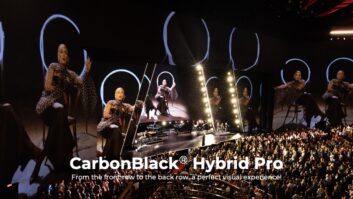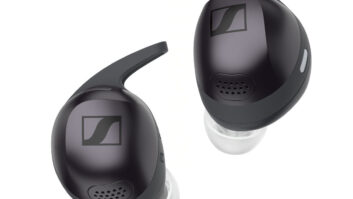New York — Suppliers firmed up the pricing and availability of the latest XM Satellite Radio headphone stereos, having missed their previously announced first quarter ship dates.
Pioneer plans to ship the $399-suggested Inno during the first week of May. Samsung will ship its Helix at $399 in mid- to late May. Meanwhile Samsung’s $219-suggested neXus 25 and $269 neXus 50 will ship during the second week of May.
All four battery-powered models incorporate embedded flash-memory to record XM broadcasts and to store compressed music files transferred from a PC. Like MP3 files, XM-broadcast music stored in memory can be recalled by title, artist or genre.
Because of their satellite radio recording capabilities, they are targeted in part to consumers who do not have the time to download or rip music on a PC. “There’s no need to own a PC to participate in the MP3 generation,” said Bill Hadam, Samsung digital audio marketing director.
Samsung managers attributed their company’s delay primarily to software development. XM, which is new to the MP3 business, needed more time to fine-tune the devices’ MP3 software, and Samsung itself was new to the satellite radio market, the managers said. Pioneer didn’t comment at press time.
The Pioneer Inno and Samsung Helix are the first headphone MP3 players with built-in satellite radio tuners, enabling them to receive live satellite radio programs on the go as well as store and play back compressed music files transferred from a PC. They store MP3 and WMA music files. That includes authorized a la carte WMA downloads but not subscription-based downloads.
The two devices also record and store XM songs for later recall by artist, title or genre. Channels and individual songs can be recorded as they’re played. As Samsung’s Hadam said, “Hear it. Click it. Save it.” In addition, when the Helix and Inno are snapped into an included home docking station/recharger, they can be programmed like a VCR to time-shift channels for later playback.
Both models feature 1GB of embedded memory, enabling them to store up to 50 hours of XM music, which remains playable until the user’s XM subscription lapses. They store fewer hours of MP3 and WMA files because of the two codecs’ larger file sizes. Users can select the amount of memory they want to dedicate to recorded XM programs and to their own compressed-music files. Once the memory is partitioned, however, it can’t be reallocated without erasing all stored files.
The Inno and Helix, part of XM’s XM2go selection of XM headphone stereos with built-in tuners, also feature built-in FM transmitter to beam XM programming and stored content to home and car audio systems.
Both devices feature built-in satellite radio antenna, but for poor signal areas, an optional headphone with built-in antenna is available. A car docking station with magnet-mount antenna is also optional. Additional home docks are also available.
Samsung’s neXus 25 and 50 headphone stereos, in contrast, do not incorporate satellite tuners for on-the-go reception of live XM programs, but they do store compressed-music files and recorded XM programming. They ship with a home docking station whose removable Passport satellite-tuner module is controlled from the docked portables’ control buttons. While docked, the portables can record broadcast programs as they’re heard as well as be programmed to time-shift programs.
A car dock with built-in FM transmitter is optional.
The neXus 25 features 512MB of embedded memory to store 25 hours of XM-transmitted music. The neXus 50 features 1GB memory to store 50 hours of XM music.
All four devices feature a bookmark function that lets users bookmark a song broadcast by XM, simplifying the purchase of the song from the XM+Napster site after the devices are docked with a PC.
The neXus models were originally planned for fourth-quarter 2005 availability before being postponed until the first quarter and then again until May.
All four devices will appeal to consumers who don’t have the time to rip or download music on a PC and don’t want to deal with the complexity of downloading, said Dinesh Moorjani, Samsung’s senior manager for new business development. He called the MP3 downloading and ripping experience “cumbersome” compared to the “smooth, intuitive experience” of using an analog Walkman.
The new portables, he stressed, “marry music discovery and fulfillment,” an experience that he said hasn’t existed until the launch of products such as these, and “take iPod [download] simplicity a step farther.”
Though the four portables are hybrid XM/MP3 players, Samsung sees the inclusion of live XM reception in the Helix and Inno models XM demand segmenting according to a consumer’s lifestyle. Headphone portables with built-in XM tuners will appeal people who are frequently outdoors, whether walking to work, walking or running for exercise, commuting on mass transit, and hiking, said Hadam. These devices will also appeal to people interested in listening to live news and sports broadcasts. The neXus portables without built-in XM tuners will appeal to “the average MP3 user,” including people who use MP3 players to work out indoors in a gym.
The portables and a quartet of XM-ready home theater in a box (HTiB) systems are Samsung’s first satellite-radio products. The four XM-ready HTiBs just began shipping at street prices of $299, $379, $429 and $529. They control outboard $49 Connect and Play antennas with integrated XM tuner and $29.99-suggested Passport mini tuners, which plug into a $29.99 home docking station with included antenna. Passport mini tuners can be shuttled between home and car docking stations without disturbing the location of a carefully placed antenna in the home.













